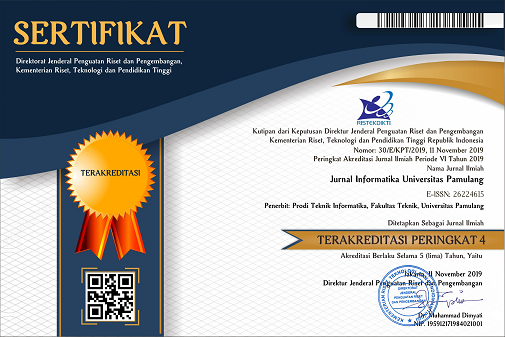Implementasi Algoritme Decision Tree (C4.5) dengan Optimize Weights (PSO) untuk Memprediksi Kelulusan Mahasiswa Tepat Waktu
DOI:
https://doi.org/10.32493/informatika.v6i2.9197Keywords:
Decision Tree (C4.5), Particle Swarm Optimization (PSO), Student GraduationAbstract
The implementation of quality education is a requirement for higher education institutions to produce quality students. Government regulations regarding the limitation of the maximum length of lectures that students can take are intended so that the institutions involved in the educational process have careful planning in the learning process. Good planning is expected to be able to accreditation value of higher education institutions and deliver student studies so that they can graduate on time. In order to achieve these results, aspects that are so influential on the optimal value of accreditation results are needed, one of which is that students graduate on time and play an importan role in determining the results of accreditation. Decision tree itself is a very simple algorithm and easy understanding, decision tree algorithm alonei is enough to produc good and optimal accuracy values. Therefore, the optimization method particle swarm optimization (PSO) with its advantages can increase the level of accuracy by removing irrelevant features. The results of the study using a student dataset of class 2016 - 2017 explain that the optimization ofparticle swarm optimization (PSO) can produce 92.36% accuracy and increase the accuracy of 01.05%, with the decision tre method C4.5 with an accuracy rate of 91.31%. Furthermore, the T-test testing process is carried out on the decision tree algorithm C4.5 and the decison tree algorithm C4.5 optimization of particle swarm optimization (PSO) with the final result alpha = 0.635 where the results are less significant, it is said to be significant if the test results are below alpha = 0.050.
References
Agus, B., Irwansyah, Egi, P., andi, A. P., & Ninuk, W. (2020). Komparasi Algoritma Decision Tree, Naive Bayes Dan KNearest Neighbor Untuk Memprediksi Mahasiswa Lulus Tepat Waktu. Juenal Ilmu Pengetahuan dan Teknilogi Komputer, 265 - 270.
Arie, Y. S., & Yogi, P. (2018). Penerapan Teknik Klasifikasi Untuk Prediksi Kelulusan Mahasiswa Menggunakan Algoritma KNearest Neighbour. Techno.COM, 395 - 403.
Brijesh, K. B., & Saurabh, P. (2011). Data Mining: A predictioon for performance improvement using classification. (IJCSIS) International Journal of Computer Science and Information Security.
Devi, S., Ichsan, T., Jumadi, & Wildan, B. Z. (2016). Klasifikasii Terjemahan Ayat Al-Quran Tentang Ilmuu Sains Menggunakan Algoritma Decision Tre Berbasis Mobile. (JOIN) Jurnal Online Informatika, 24 - 27.
Eko, P., Kusrini, & Sudarmawan. (2019). Prediksi Kelulusan tpat waktu Menggunakan Metode C 45 dan K-nn. TECHNO, 131 - 142.
F., G. (2011). Data Mining: Concepts, Models and Technique. USE.
Hong-qi, T., Hui, L., Chao, C., & Yan-fei, L. (2013). An experimental investigaton of two Wavelet-MLP hybrid frameworkss for wind speed prediction using GA and PSO optimization. Electrical Powerr and Energy Systems, 161–173.
Hongyan, C., Jianfang, C., Hao, S., & Lijuan, J. (2016). Big Data: A Parallel Partcle Swarm Optimization-Back-Propagation Neural Network Algorithm Based MapReduce. PLoS One, 1 - 17.
R.M., H., F., V., & Perez-, R. (2008). Priorities for fisheries in marine protected areea design and management: Implicatioons for artisanal-type fisheries as found in southern Europe. Journal forNature Conservation, 222 - 233.
S., H., & D., H. K. (2014). Implementasi Data Mining dengan Algoritma C4.5i untuk Memprediksi Tingkat Kelulusan Mahasiswa. Jurnal ULTIMATICS, 15 - 20.
Selvia, L. B., Wendi, Z., & Ida, H. (2014). Analisis Dan Penerapannn Algoritma C4.5 Dalam Data Mining Untukk Memprediksi Masa Studi Mahasiswa Berdasarkan Data Nilai Akademik. Prosiding Seminar Nasional Aplikasi Sains & Teknologi (SNAST) (hal. 263 - 272). Yogyakarta: 15 November 2014.
Tao, X., Yinzhao, C., & Qinke, P. (2012). Identifying the semantic orientation of terms using S-HAL for sentiment analysis. Knowledge-Based Systems, 279–289.
Verry, R., Abdul, H., & Ridwansyah. (2019). Prediction of Student Graduation Time Using The Best Algorthm. Indonesian Journal of Artificial Inteligence and Data Mining (IJAIDM), 1 - 9.
Wu, K. (2009). The Top Ten Algorithms in Data Mining. USE: Press CRC.
Downloads
Published
Issue
Section
License
Authors who publish with this journal agree to the following terms:
- Authors retain copyright and grant the journal right of first publication with the work simultaneously licensed under a Creative Commons Attribution-NonCommercial 4.0 International (CC BY-NC 4.0) that allows others to share the work with an acknowledgement of the work's authorship and initial publication in this journal.
- Authors are able to enter into separate, additional contractual arrangements for the non-exclusive distribution of the journal's published version of the work (e.g., post it to an institutional repository or publish it in a book), with an acknowledgement of its initial publication in this journal.
- Authors are permitted and encouraged to post their work online (e.g., in institutional repositories or on their website) prior to and during the submission process, as it can lead to productive exchanges, as well as earlier and greater citation of published work (See The Effect of Open Access).
Jurnal Informatika Universitas Pamulang have CC-BY-NC or an equivalent license as the optimal license for the publication, distribution, use, and reuse of scholarly work.
In developing strategy and setting priorities, Jurnal Informatika Universitas Pamulang recognize that free access is better than priced access, libre access is better than free access, and libre under CC-BY-NC or the equivalent is better than libre under more restrictive open licenses. We should achieve what we can when we can. We should not delay achieving free in order to achieve libre, and we should not stop with free when we can achieve libre.
Jurnal Informatika Universitas Pamulang is licensed under a Creative Commons Attribution-NonCommercial 4.0 International (CC BY-NC 4.0)
YOU ARE FREE TO:
- Share : copy and redistribute the material in any medium or format
- Adapt : remix, transform, and build upon the material for any purpose, even commercially.
- The licensor cannot revoke these freedoms as long as you follow the license terms





